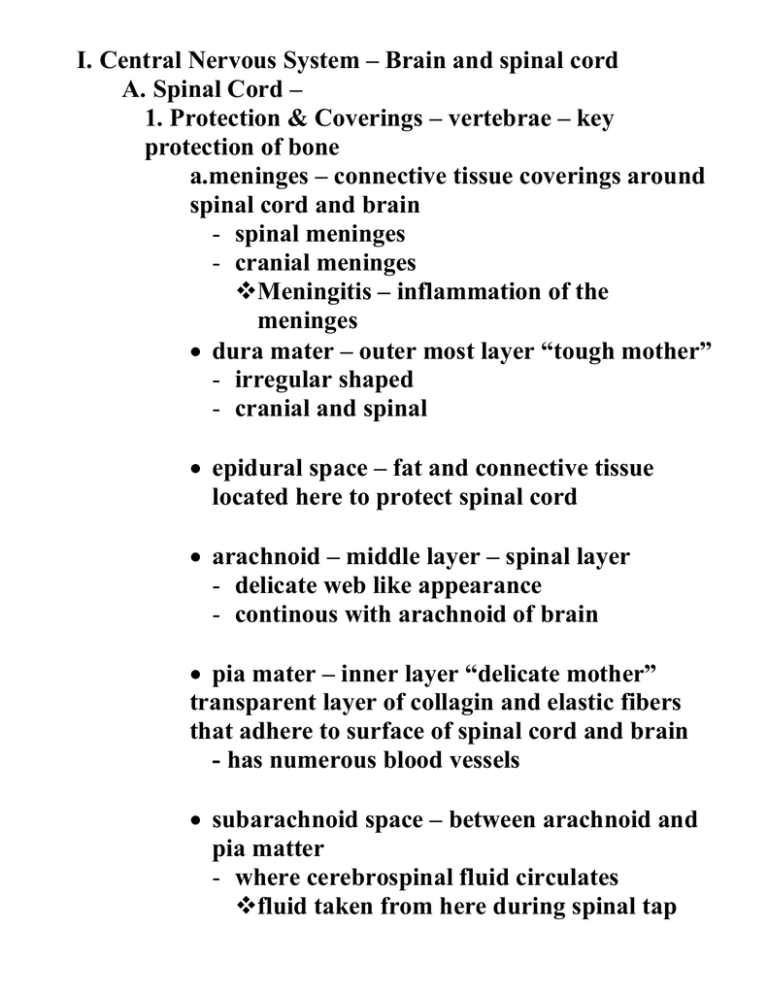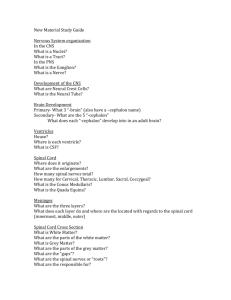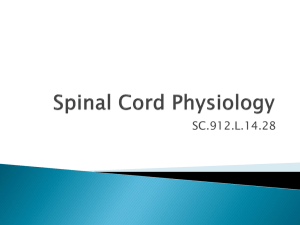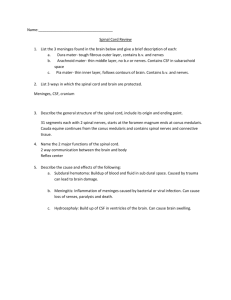I. Central Nervous System – Brain and spinal cord
advertisement

I. Central Nervous System – Brain and spinal cord A. Spinal Cord – 1. Protection & Coverings – vertebrae – key protection of bone a.meninges – connective tissue coverings around spinal cord and brain - spinal meninges - cranial meninges Meningitis – inflammation of the meninges dura mater – outer most layer “tough mother” - irregular shaped - cranial and spinal epidural space – fat and connective tissue located here to protect spinal cord arachnoid – middle layer – spinal layer - delicate web like appearance - continous with arachnoid of brain pia mater – inner layer “delicate mother” transparent layer of collagin and elastic fibers that adhere to surface of spinal cord and brain - has numerous blood vessels subarachnoid space – between arachnoid and pia matter - where cerebrospinal fluid circulates fluid taken from here during spinal tap 2. General Features a. length – 42-45 cm (16-18 inches) - extend from foramen magnum to 2nd lumbar vertebrae (not entire length of vertebral column) b. cauda equina – nerves arising from lower portion of cord angles down – “horses trail” c. cervical enlargement – contains upper extremity nerves d. lumbar enlargement – nerves for lower extremity e. spinal segments – 31 spinal segments 3. Cross section structure – page 232 a. anterior median fissure - deep b. posterior median sulcus – shallow c. gray matter – H shaped – surrounded by white matter d. white matter – outer layer 4. Functions – a. impulse conduction – spino thalamic tracts – pain, temperature, crude touch, deep pressure posterior column tracts proprioception – muscle movement, awareness discriminative touch 2 point discrimination pressure vibrations pyramidal tracts – precise skeletal muscle movements extrapyramidal tracts – head movements muscle tone posture equilibrium b. reflex center – spinal reflexes - fast, predictable, automatic response to a change in the environment spinal nerves connect spinal cord tracts and periphery – each pair connects at roots – posterior (dorsal root) – sensory only – to gray horn dorsal root ganglion – swelling anterior (ventral) – motor root – takes to periphery c. reflex arc and homeostasis - pathway – origin – termination 1. receptor – sensory neuron portion – generates impulse 2. sensory neuron 3. integrating center – part of CNS – on to motor 4. motor neuron – to organ 5. effector – muscle or gland that responds B. Spinal nerves – connects CNS to sensory receptors, muscles and glands – part of SNS – 31 pairs 1. Names – named by region and level of spinal cord from where they emerge – 8 pair cervical, 12 pair thoracic, 5 pair lumbar, 5 pair sacral, 1 pair coccygeal - 1st pair exits the spinal cord between the atlas and the occipital bone – all others exit through intervertebral foramina 2. Composition - anterior and posterior root attachments - mixed nerve – both sensory and motor fibers 3. Distribution – a. branches – rami – dorsal, ventral b. plexuses – ventral except T2 to T11 form networks of nerves on both sides called plexuses – cervical, brachial, lumbar, sacral (pg 256) c. intercostal nerves – T2 to T11 intercostal or thoracic nerves – muscles between ribs, abdominal, skin, chest and back C. Brain – (mushroom shaped) – one of the largest shaped organs – weighs 3 lbs (1300g) - 4 parts – protected by cranium and meninges 1. Cerebrospinal fluid – CSP – circulates through subarachnoid space, around brain and spinal cord and through ventrictes of brain - ventricles – cavities of brain that communicate with each other - 2 lateral, 1 3rd and 1 4th ventricles - 80-150 ml of CSF in CNS - contains glucose, proteins, urea, and salts - protects (shock absorber) – circulation functions 2. Blood supply – hydrocephalus – tumor or blockage which causes accumulation - well supplied with O2 and nutrients by a circulatory route called circle of willis – (fig 16.9) -brain requires 20% of body’s oxygen - brief interruption - faint - 1-2 min weakens cells, 4 min – permanent injury because lysosomes destroy brain cells by releasing enzymes - blood also contains glucose – BBB blood brain barrier controls rates - protects brain cells but antibiotic cannot enter 3. Brain Stem – brain has no carbo storage so it needs constant glucose - Medulla oblongata - continuation of spinal cord - contains all ascending and descending tracts between spinal cord and brain (white matter) - 2 triangular pyramids – crosses sides decussation of pyramids – one side controls other side - severe blow to mandible twists and distorts brain stem – (knock out) - regulates rate and force of heartbeat and breathing rhythm - Pons – bridge – located above medulla and consists of nucleii and scattered white fibers - connects spinal cord to brain and brain parts together - helps regulate breathing - Midbrain – pons to lower portion of diencephalon - contains motor fibers that connect cerebral cortex to pons and spinal cord - fibers that connect spinal cord to thalamus - nuclei for oculomotor and truchlear nerves 4. Diencephalon – “through brain” - Thalamus – mostly gray matter – serves as relay station for sensory impulses Interpret impulses like pain, temperature, light touch and pressure - Hypothalamus – contains mostly homeostatic mechanisms 1. autonomic nervous system – heart rate, gastrovascular movement, urinary bladder contraction 2. body temperature 3. rage and aggression 4. food intake 5. thirst center 6. conciousness and sleep patterns 5. RAS – reticular activating system - circadian rhythm – 24 hr sleep and wake pattern - arousal caused by thalamus - conciousness is a result – inactivation results in sleep - feedback causes increased activation - altered by cocaine, amphetamines, meditation, alcohol, anesthetics - coma 6. Cerebrum – bulk of brain - cerebral cortex thin area of gray matter - 6 layers of nerve cell bodies - during development – the brain increases in size and gray matter enlarges faster than white matter – thus it folds (fissures) longitudinal fissure – separates left and right (hemispheres) - corpus callosum – white matter that contains fibers connecting the hemispheres – larger in female - Lobes – each hemisphere has 4 lobes divided by sulci (shallow)or fissures (deep) frontal, parietal, temporal, and occipital - Brain lateralization - left handed – parietal, occipital lobes of RT hemisphere are narrower and frontal of left is narrower - left hemisphere – right handed control spoken and written language, numerical, scientific skills and reasoning - White matter – myelinated axons – 3 directions 1. association fibers – transmit impulses between gyri of same hemispheres 2. commissural fiber – one side to another ex – corpus callosum 3. projection fibers – transmit from cerebrum to other parts of brain - Basal Ganglia - paired masses of gray matter within white of each hemisphere - control subconscious movements (swinging of arms while walking) - damage – uncontrollable shaking – Parkinson’s - Stroke – total paralysis of one side opposite damage - Limbic system - wishbone shaped group of structures encircling the brain stem and controls emotions of pain, pressure, anger, rage, fear, sorrow, sexual feelings, and affection - also with cerebrum – functions in memory - Functional areas (3 general) 1. sensory – visual, auditory, gustatory and olfactory 2. motor – muscular, language 3. association – motor and sensory connection (pg 231) 4. memory – engram - memory trace in brain that represents an experience 7. Cerebellum – 2nd largest portion – behind medulla and pons and below occipital lobes - surface (cortex) consists of gray matter - white matter resembles branches of tree - subconcious skeletal movement for coordination, balance and posture - ataxia – lack of coordination D. Neurotransmitters 1. Acetylcholine – usually excitatory, skeletal neuro muscular junctions 2. Dopamine – emotional responses, subconscious movement of skeletal muscle – Parkinson’s 3. Norephinephrine – neuro muscular and neuro glandular junctions – related to arousal, dreaming and mood 4. Seratonin – inhibitory – inducing sleep, sensory perception, temp regulation and mood 5. Gamma aminobutric acid – inhibitory – target of anti-anxiety drugs like valium 6. Substance P – associated with pain – stimulates percelption of pain – opposite of endorphins 7. Enkephalins – suppress substance P 8. Endorphins – inhibit substance P and have pole in memory, learning, sexual activity - have been linked to depression and schizopherenia E. Cranial nerves Somatic Nervous System – 12 pairs of nerves – 10 pair organized from brain stem - Roman numerals - designate - some only sensory - remainder are mixed







